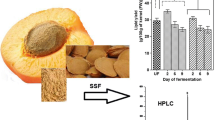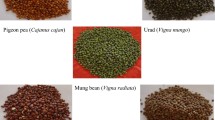Abstract
The use of agro-industrial residues for production of bio-functional products has aroused the interest of scientists as a positive step towards ecological sustainable. In this study, Pleurotus ostreatus or Calocybe indica was used in solitary and were combined in solid state fermentation to improve bioactivities of extracts from cocoa pod husk (CPH) and kolanut pod (KP). The bioactive compounds in extracts were revealed using Gas chromatography–mass spectrometry (GCMS). Phenolic and flavonoid contents of studied extracts were within 34.80–56.9 mg/g Gallic acid equivalent and 11.50–31.5 mg/g Quercertin equivalent, respectively. Extracts from unfermented and fermented pods of Theobroma cacao and Cola spp. displayed notable antimicrobial activity against indicator microorganisms with zones of inhibition ranged from 5.0 to 18.0 mm. Minimum inhibitory concentration of the extracts against microorganisms ranged from 2.5 to 10.0 mg/ml. IC50 of extracts against free radicals ranged from 0.3 to 1.7 mg/ml, 0.4–1.7 mg/ml and 0.4–1.8 mg/ml for DPPH, Fe and OH−, respectively. Some of bioactive compounds identified using GCMS were phenol, glycerine, pimelic ketone, D-ribonic acid, methyl myristate, palmitic acid methyl ester, oleic acid ethyl ester, lauramide, oleic acid amide, 1,2-cyclododecanediol, resorcinol, phytol and others. The bioactivities of extracts from unfermented and fermented CPH and KP can be attributed to the presence of assorted bioactive compounds, which can be exploited as antimicrobial, antioxidant, anti-inflammatory, immunomodulatory, antitumor promoting agents and therefore, useful for production of functional foods, pharmaceuticals, and cosmetics.




Similar content being viewed by others
References
Adebayo SA, Oladele OI (2012) Medicinal values of Kolanut in Nigeria: implication for extension service delivery. Life Sci J 9(2):887–891
Adesanwo JK, Ogundele SB, Akinpelu DA, McDonald AG (2017) Chemical analyses, antimicrobial and antioxidant activities of extracts from Cola nitida seed. J Explor Res Pharmacol 2:67–77
Adi-Dako O, Ofori-Kwakye K, Manso SF, Boakye-Gyasi MEL, Sasu C, Pobee M (2016) Physicochemical and antimicrobial properties of cocoa pod husk pectin intended as a versatile pharmaceutical excipient and nutraceutical. J Pharm 2016:1–12
Anwar H, Hussain G, Mustafa I (2018) Antioxidants from natural sources. In: Shalaby E, Azzam GM (eds) Antioxidants in foods and its applications. IntechOpen, London
Ariza BTS, Mufida DC, Fatima NN, Hendrayati TI, Wahyudi T, Misnawi M (2014) In vitro antibacterial activity of cocoa ethanolic extract against Escherichia coli. Int Food Res J 21(3):935–940
Baiano A (2014) Recovery of biomolecules from food wastes—a review. Molecules 19:14821–14842
Bhanja DT, Kuhad RC (2014) Enhanced production and extraction of phenolic compounds from wheat by solid-state fermentation with Rhizopus oryzae RCK2012. Biotechnol Rep 20(4):120–127. https://doi.org/10.1016/j.btre.2014.09.006
Bringman G, Gramatokis S, Proksch P (1992) Feeding detergency and growth retarding activity of the thylisoquinoline alkaloid dioncyphylline A against Spodoptera littoralis. Phytochemistry 32:3821–3825
Cai S, Wang O, Wu W, Zhu S, Zhou F, Ji B, Gao F, Zhang D, Liu J, Cheng Q (2012) Comparative study of the effects of solid-state fermentation with three filamentous fungi on the total phenolics content (TPC), flavonoids, and antioxidant activities of subfractions from oats (Avena sativa L.). J Agric Food Chem 60(1):507–513. https://doi.org/10.1021/jf204163a
Cheesbrough M (2006) District laboratory practices in tropical countries. Part 2. 2nd Edition. Cambridge University Press, New York
Chukwuma OB, Rafatullah M, Tajarudin HA, Ismail N (2020) Lignocellulolytic enzymes in biotechnological and industrial processes: a review. Sustainability 12:7282
Couto SR, Sanromán MÁ (2006) Application of solid-state fermentation to food industry—a review. J Food Eng 76(3):291–302
Dah-Nouvlessounon D, Adoukonou-Sagbadja H, Diarrassouba N, Sina H, Adjanohoun A, Inoussa M, Akakpo D, Gbenou JD, Kotchoni SO, Dicko MH, Baba-Moussa L (2015) Phytochemical analysis and biological activities of Cola nitida Bark. Biochem Res Int 2015:1–12. https://doi.org/10.1155/2015/493879
Darwish GAMA, Bakr AA, Abdallah MMF (2012) Nutritional value upgrading of maize stalk by using Pleurotus ostreatus and Saccharomyces cerevisiae in solid state fermentation. Ann Agric Sci 57(1):47–51
Di Donato P, Taurisano V, Tommonaro G et al (2018) Biological properties of polyphenols extracts from agro industry’s wastes. Waste Biomass Valor 9:1567
Dulf FV, Vodnar DC, Socaciu C (2016) Effects of solid-state fermentation with two filamentous fungi on the total phenolic contents, flavonoids, antioxidant activities and lipid fractions of plum fruit (Prunus domestica L.) by-products. Food Chem 209:27–36. https://doi.org/10.1016/j.foodchem.2016.04.016
Ezifeka GO, Onji MU, Mbata TI, Patrick AO (2004) Antimicrobial activities of Cajanus Cajan, Garcinia kola seeds and Xylopia aethiopica on pathogenic microorganisms. J Biol Sci 8(1):49–154
Fabunmi TB, Arotupin DJ (2015) Antioxidant properties of fermented kolanut husk and testa of three species of kolanut: Cola acuminata, Cola nitida and Cola verticillata. Br Biotechnol J 8(2):1–13
Ferronato N, Torretta V (2019) Waste mismanagement in developing countries: a review of global issues. Int J Environ Res Public Health 16(6):1060. https://doi.org/10.3390/ijerph16061060
Górniak I, Bartoszewski R, Króliczewski J (2019) Comprehensive review of antimicrobial activities of plant flavonoids. Phytochem Rev 18:241–272. https://doi.org/10.1007/s11101-018-9591-z
Haile M, Kang W (2019) Antioxidant activity, total polyphenol, flavonoid and tannin contents of fermented green coffee beans with selected yeasts. Fermentation 5(1):29
Halliwell B, Gutteridge J (2007) Free radicals in biology and medicine, 4th edn. Oxford University Press, Oxford
Harbone J (1998) Phytochemical methods: a guide to modern techniques of plant analysis, 3rd edn. Chapman and Hill, London, p 279
Harborne SB, Baxter H (1995) Phytochemical dictionary: a handbook of bioactive compounds from plants. Taylor and Francis, London
Huang L, Sun N, Ban L, Wang Y, Yang H (2019) Ability of different edible fungi to degrade crop straw. AMB Express 9:4
Kerem Z, Friesem D, Hadar Y (1992) Lignocellulose degradation during solid-state fermentation: Pleurotus ostreatus versus Phanerochaete chrysosporium. Appl Environ Microbiol 58(4):1121–1127
Kim J, Kim J, Shim J, Lee CY, Lee KW, Lee HJ (2014) Cocoa phytochemicals: recent advances in molecular mechanisms on health. Crit Rev Food Sci Nutr 54:1458–1472
Kumar A, Chandra R (2020) Ligninolytic enzymes and its mechanisms for degradation of lignocellulosic waste in environment. Heliyon 6(2):e03170
Lecumberri E, Mateos R, Izquierdo-Pulido M, Rupérez P, Goya L, Bravo L (2007) Dietary fibre composition, antioxidant capacity and physicochemical properties of a fibre-rich product from cocoa (Theobroma cacao L.). Food Chem 104(3):948–954
Lessa OA, Reis NDS, Leite SGF, Gutarra MLE, Souza AO, Gualberto SA, de Oliveira JR, Aguiar-Oliveira E, Franco M (2017) Effect of the solid state fermentation of cocoa shell on the secondary metabolites, antioxidant activity, and fatty acids. Food Sci Biotechnol 27(1):107–113. https://doi.org/10.1007/s10068-017-0196-x
Lizardi-Jiménez MA, Hernández-Martínez R (2017) Solid state fermentation (SSF): diversity of applications to valorize waste and biomass. 3 Biotech 7(1):44–55. https://doi.org/10.1007/s13205-017-0692-y
Meda A, Lamien CE, Romito M, Milligo J, Nacoulma OG (2005) Determination of the total phenolic, flavonoid and proline contents in Burkina Fasan honey as well as their radical scavenging activity. Food Chem 91(3):571–577. https://doi.org/10.1016/j.foodchem.2004.10.006
Mingshu LK (2006) Biodegradation of gallotannins and ellagitannins. J Basic Microbiol 46:68–84
Puntel RL, Nogueira CW, Rocha JBT (2005) Krebs cycle intermediates modulate thiobarbitu-ric acid reactive species (TBARS) production in rat brain in vitro. Neurochem Res 30(2):225–235. https://doi.org/10.1007/s11064-004-2445-7
Rachmawaty MA, Hasri PH, Hartati MZ (2018) Active compounds extraction of cocoa pod husk (Thebroma cacao L.) and potential as fungicides. J Phys Conf Ser. In: 2nd international conference on statistics, mathematics, teaching, and research. IOP conference series. https://doi.org/10.1088/1742-6596/1028/1/012013
Sadh PK, Duhan S, Duhan JS (2018) Agro-industrial wastes and their utilization using solid state fermentation: a review. Biores Bioproc. https://doi.org/10.1186/s40643-017-0187-z
Sagar NA, Pareek S, Sharma S Yahia, Elhadi M, Lobo MG (2018) Fruit and vegetable waste: bioactive compounds, their extraction, and possible utilization. Compr Rev Food Sci Food Saf 17(3):512–531
Salahdeen HM, Omoaghe AO, Isehunwa GO, Murtala BA, Alada ARA (2015) Gas chromatography mass spectrometry (GC–MS) analysis of ethanolic extracts of kolanut (Cola nitida) (vent) and its toxicity studies in rats. J Med Plants Res 9(3):56–70
Santos RX, Oliveira DA, Sodré GA, Gosmann G, Brendel M, Pungartnik C (2014) Antimicrobial activity of fermented Theobroma cacao pod husk extract. Genet Mol Res 13(3):7725–7735
Scapagnini G, Davinelli S, Di Renzo L, De Lorenzo A, Olarte HH, Micali G, Cicero AF, Gonzalez S (2014) Cocoa bioactive compounds: significance and potential for the maintenance of skin health. Nutrients 6(8):3202–3213. https://doi.org/10.3390/nu6083202
Sharma G, Vivek GAK, Ganjewala D, Gupta C, Prakash D (2010) Phytochemical composition, antioxidant and antibacterial potential of underutilized parts of some fruits. Int Food Res J 24(3):1167–1173
Shirahigue LD, Ceccato-Antonini SR (2020) Agro-industrial wastes as sources of bioactive compounds for food and fermentation industries. Ciência Rural 50(4):e20190857. https://doi.org/10.1590/0103-8478cr20190857
Singh A, Kuila A, Adak S, Bishai M, Banerjee R (2012) Utilization of vegetable wastes for bioenergy generation. Agric Res 1(3):213–222
Soccol CR, Ferreira da Costa ES, Junior Letti LA, Karp SG, Woiciechowski AL, de Souza Vandenberghe LP (2017) Recent developments and innovations in solid state fermentation. Biotechnol Res Innov 1:52–71
Sonibare MA, Soladoye MO, Esan OO, Sonibare OO (2009) Phytochemical and antimicrobial studies of four species of Cola Schott and Endl. (Sterculiaceae). Afr J Tradit Complement Altern Med 6(4):518–525
Thomas L, Larroche C, Pandey A (2013) Current developments in solid-state fermentation. Biochem Eng J 81:146–161
Trease GE, Evans MC (2005) Pharmacognosy, 14th edn. Elsevier, New Delhi
Ugwuanyi JO, McNeil B, Harvey LM (2009) Production of protein-enriched feed using agro-industrial residues as substrates. In: Nee´Nigam PS, Pandey A (eds) Biotechnology for agro-industrial residues utilisation. Springer, New York, pp 77–104
Vattem DA, Lin YT, Labbe RG, Shetty K (2004) Phenolic antioxidant mobilization in cranberry pomace by solid-state bioprocessing using food grade fungus Lentinus edodes and effect on antimicrobial activity against select food borne pathogens. Innov Food Sci Emerg Technol 5:81–91. https://doi.org/10.1016/j.ifset.2003.09.002
Verduzco-Oliva R, Gutierrez-Uribe JA (2020) Beyond enzyme production: solid state fermentation (SSF) as an alternative approach to produce antioxidant polysaccharides. Sustainability 12:495. https://doi.org/10.3390/su12020495
Yazid NA, Barrena R, Komilis D, Sánchez A (2017) Solid-state fermentation as a novel paradigm for organic waste valorization: a review. Sustainability 9(2):224
Yusof F, Khanahmadi S, Amid A, Mahmod SS (2016) Cocoa pod husk, a new source of hydrolase enzymes for preparation of cross-linked enzyme aggregate. SpringerPlus 5:57
Zhang Z, Lv G, Pan H, Fan L, Soccol CR, Pandey A (2012) Production of powerful antioxidants supplements via solid-state fermentation of wheat (Triticum aestivum Linn.) by Cordyceps militaris. Food Technol Biotechnol 50:32–39
Funding
Not applicable.
Author information
Authors and Affiliations
Corresponding author
Ethics declarations
Ethical statement
This article does not contain any studies with human participants or animals performed by any of the authors.
Conflict of Interest
Clement Olusola Ogidi has no conflict of interest. Sadeeq Adewale Abioye has no conflict of interest. Damilola Deborah Akinyemi has no conflict of interest. Felix Bukola Fadairo has no conflict of interest. Tolulope Bolaniran has no conflict of interest. Bamidele Juliet Akinyele has no conflict of interest.
Additional information
Publisher's Note
Springer Nature remains neutral with regard to jurisdictional claims in published maps and institutional affiliations.
Rights and permissions
About this article
Cite this article
Ogidi, C.O., Abioye, S.A., Akinyemi, D.D. et al. Bioactivity assessment of ethanolic extracts from Theobroma cacao and Cola spp. wastes after solid state fermentation by Pleurotus ostreatus and Calocybe indica. ADV TRADIT MED (ADTM) 22, 333–345 (2022). https://doi.org/10.1007/s13596-020-00543-6
Received:
Accepted:
Published:
Issue Date:
DOI: https://doi.org/10.1007/s13596-020-00543-6




